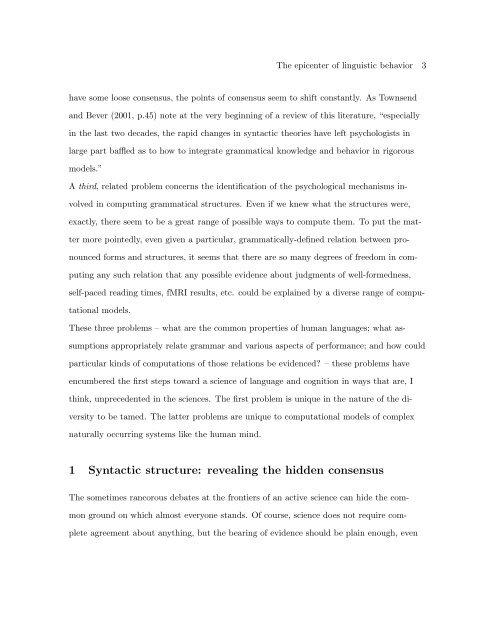The epicenter of linguistic behavior - UCLA Department of Linguistics
The epicenter of linguistic behavior - UCLA Department of Linguistics
The epicenter of linguistic behavior - UCLA Department of Linguistics
You also want an ePaper? Increase the reach of your titles
YUMPU automatically turns print PDFs into web optimized ePapers that Google loves.
<strong>The</strong> <strong>epicenter</strong> <strong>of</strong> <strong>linguistic</strong> <strong>behavior</strong> 3<br />
have some loose consensus, the points <strong>of</strong> consensus seem to shift constantly. As Townsend<br />
and Bever (2001, p.45) note at the very beginning <strong>of</strong> a review <strong>of</strong> this literature, “especially<br />
in the last two decades, the rapid changes in syntactic theories have left psychologists in<br />
large part baffled as to how to integrate grammatical knowledge and <strong>behavior</strong> in rigorous<br />
models.”<br />
A third, related problem concerns the identification <strong>of</strong> the psychological mechanisms involved<br />
in computing grammatical structures. Even if we knew what the structures were,<br />
exactly, there seem to be a great range <strong>of</strong> possible ways to compute them. To put the matter<br />
more pointedly, even given a particular, grammatically-defined relation between pronounced<br />
forms and structures, it seems that there are so many degrees <strong>of</strong> freedom in computing<br />
any such relation that any possible evidence about judgments <strong>of</strong> well-formedness,<br />
self-paced reading times, fMRI results, etc. could be explained by a diverse range <strong>of</strong> computational<br />
models.<br />
<strong>The</strong>se three problems – what are the common properties <strong>of</strong> human languages; what assumptions<br />
appropriately relate grammar and various aspects <strong>of</strong> performance; and how could<br />
particular kinds <strong>of</strong> computations <strong>of</strong> those relations be evidenced? – these problems have<br />
encumbered the first steps toward a science <strong>of</strong> language and cognition in ways that are, I<br />
think, unprecedented in the sciences. <strong>The</strong> first problem is unique in the nature <strong>of</strong> the diversity<br />
to be tamed. <strong>The</strong> latter problems are unique to computational models <strong>of</strong> complex<br />
naturally occurring systems like the human mind.<br />
1 Syntactic structure: revealing the hidden consensus<br />
<strong>The</strong> sometimes rancorous debates at the frontiers <strong>of</strong> an active science can hide the common<br />
ground on which almost everyone stands. Of course, science does not require complete<br />
agreement about anything, but the bearing <strong>of</strong> evidence should be plain enough, even
















